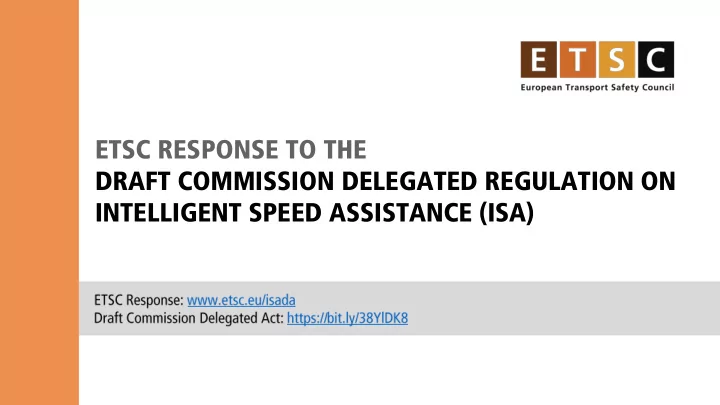

ETSC RESPONSE TO THE DRAFT COMMISSION DELEGATED REGULATION ON INTELLIGENT SPEED ASSISTANCE (ISA)
DRAFT DELEGATED ACT ALLOWS FOR 4 TYPES OF FEEDBACK 1. visual warning + cascaded acoustic warning 2. visual warning + cascaded haptic warning: a) increasing the restoring force of the accelerator pedal; or b) vibrating the accelerator control 3. haptic warning alone (increasing the restoring force on the accelerator control 4. speed control function (SCF)
ETSC CALLS FOR: 1. Cascading acoustic warnings and vibrating pedal not to be included as potential feedback, as they are neither appropriate nor effective 2. Only 2 feedback modes to be allowed: Always VISUAL warning + a) Haptic pedal = increasing the restoring force of the accelerator control; or b) Speed Control Function (SCF) Each encountered speed limit can individually be overridden in both a) and b) type systems.
• •
• • • https://bit.ly/hmi-isa-study https://bit.ly/isa-hmi-pb
Carsten et al. (2020) – Background Intelligent Speed Assistance (ISA) is coming as part of the GSR package, but the Human Machine Interface (HMI) was not specified. Aim of of study dy To recommend suitable Human Machine Interfaces (HMIs) for ISA, by examining: • How effective they are in curtailing speeding • How accepted they are by drivers The assumption is that a “good” ISA needs to be both effective in curtailing speeding as well as be acceptable to drivers.
Carsten et al. (2020) – Experimental Design • Within participant, i.e. each participant drove each of the conditions below • 6 conditions: • Baseline with no ISA • 5 x ISA HMIs, all with visual warning: • Auditory warning (beep) (could not be turned off) • Haptic (force feedback) pedal • Vibrating pedal • Speed control + vibrating pedal • Speed control
Carsten et al. (2020) – Participants • All of the chosen HMIs allow drivers to override the feedback (i.e. to exceed the speed limit if they choose to do so, as required by legislation) • BUT in the experiment, the participants were not given the option to switch off the ISA feedback, since that would have effectively negated the purpose of the study
Carsten et al. (2020) – Speed Compliance Total 50 45 Mean speed (mph) 40 35 30 25 20 15 10 5 0 Baseline Auditory warning Haptic pedal Vibrating pedal Speed control Speed control with vibrating alone pedal Note: UK drivers generally tend to be compliant with speed limits Graphs available for each UK speed limit in Carsten et al. (2020)
Carsten et al. (2020) – Usefulness & Satisfaction Speed Control Auditory Vibrating & Vibrating Speed Control Warning Haptic Pedal Pedal Pedal Alone 2 1,5 0,85 0,85 0,83 1 0,61 0,59 0,5 0,23 0 -0,08 -0,5 -0,53 -0,78 -1 -0,8 -1,5 Usefulness Satisfaction -2
Carsten et al. (2020) – Pleasantness & Annoyance Participants completed the pleasantness/annoyance questionnaire twice: once as though they were driving on their own and a second time as though they had a passenger in the front seat.
ETSC Position: • delete OR a visual warning and a cascaded acoustic warning, and • only allow the speed control function to be used when the driver is not expected to be touching the accelerator control, together with VISUAL warnings
MORE AMBITIOUS AND DIFFERENTIATED DETECTION RATES
EVENT-BASED DETECTION RATES Delegated Act: ≥ 90% of sign passing events that satisfy the criteria for road signs, including: • conforming to Member States’ standards on the design, size and positioning, • not damaged or partially nor fully covered… ► In reality therefore possibly much lower than 90%
ETSC RECOMMENDATION FOR DETECTION RATES FOR SPEED LIMITS EXPLICIT ≥ Permanent Temporary IMPLICIT ≥ Area Road Classification Dependent Dependent CONDITIONAL ≥ Dependent on time, weather, vehicle
DISTANCE-BASED DETECTION RATES Delegated Act The correct speed limit shall be determined for ≥ 90% of the distance driven at least for the road speed limits that satisfy the previously mentioned criteria. ETSC recommendation In line with the events-based performance requirement for implicit and conditional speed limits, ETSC calls for a minimum requirements of ≥ 95%.
DEACTIVATION OF THE ISA SYSTEM ETSC calls for: 1. Deactivation of the information about the perceived speed limit should not be allowed: SLI always ON. 2. Switching ISA OFF (for the duration of the trip) should only be allowed while in standstill AND require a complex sequence of actions by the driver. 3. Temporarily overriding one speed limit at a time can be done by pushing stronger on the accelerator or pushing one button on the steering wheel.
www.etsc.eu @etsc_eu Graziella Jost graziella.jost@etsc.eu
Recommend
More recommend